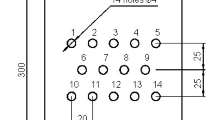The kinetics of a fatigue crack in thin isotropic plates of finite dimensions with stress concentrators under uniaxial asymmetric tension and compression is predicted. The stress concentrator is a smooth circular central hole or a circular hole with cuts. The analytical solution is obtained using a fatigue crack propagation model that combines the concepts of crack mechanics and continuous damage mechanics. Fatigue damage accumulation is assumed to be the driving force for a fatigue crack. The duration of the crack incubation period and the dependence of the fatigue crack length on the number of load cycles are calculated. The results of calculations based on the model are in agreement with experimental data.
Similar content being viewed by others
References
V. V. Bolotin, “Unified models in fracture mechanics,” Izv. AN SSSR, No. 3, 127–137 (1984).
V. V. Bolotin, “Fatigue crack growth equations,” Izv. AN SSSR, No. 4, 153–160 (1983).
V. P. Golub, V. N. Pelykh, and A. D. Pogrebnyak, “Using the equivalent-stress method to predict the fatigue life of prismatic metallic rods under repeated tension/compression,” Visn. Nats. Tekhn. Univ. Ukrainy “KPI,” Mashinobud., No. 58, 177–182 (2010).
M. P. Savruk, Stress Intensity Factors in Cracked Bodies, Vol. 2 of the four-volume Handbook V. V. Panasyuk (ed.), Fracture Mechanics and Strength of Materials [in Russian], Naukova Dumka, Kyiv (1988).
Jr. J. H. Crews, The Role of Stress Concentrations in Structural Fatigue, Dissertation, Virginia Polytechnic Institute, N69-41185, TMX-61969, May (1969).
J. H. Crews and N. H. White, Fatigue crack growth from a circular hole with and without high prior loading, NASA TN D-6899 (1972).
V. P. Golub and V. I. Krizhanovskii, “Evolution of the limiting state of materials under an asymmetric multicycle load,” Strength of Materials, 26, No. 4, 243–252 (1994).
V. P. Golub and A. V. Plashchinskaya, “Fatigue fracture model for thin isotropic plates with cracks in axial loading,” Int. Appl. Mech., 30, No. 7, 520–529 (1994).
V. P. Golub and A. V. Plashchinskaya, “On the theory of growth of fatigue mode i cracks in thin isotropic plates of finite size under uniaxial tension-compression,” Int. Appl. Mech., 54, No. 2, 188–206 (2018).
H. J. Grover, W. S. Hyler, P. Kuhn, C.B. Landers, and F. N. Hawell, Axial-Load Fatigue Properties of 24S-T and 75S-T Aluminum Alloys as Determined in Several Laboratories, NASA TN 2928 (1953).
A. N. Guz, “Nonclassical problems of fracture/failure mechanics: on the occasion of the 50th anniversary of the research (review) II,” Int. Appl. Mech., 55, No. 3, 239–295 (2019).
W. Illg and Jr. A. J. McEvily, The Rate of Fatigue-Crack Propagation for Two Aluminum Alloys under Completely Reversed Loading, NASA TN D-52 (1959).
W. Illg and Jr. A. J. McEvily, The Rate of Fatigue-Crack Propagation for Two Aluminum Alloys, NASA TN 4394 (1958).
J. C. Newman, An Approved Method of Collocation for the Stress Analysis of Cracked Plates with Various Shaped Boundaries, NASA TN D-6376 (1971).
P. C. Paris and F. Erdogan, “A critical analysis of crack propagation laws,” Trans. ASME. Ser. D. J. of Basic Eng., 85, No. 4, 528–534 (1963).
P. C. Paris, M. P. Gomez, and W. E. Anderson, “A rational analytic theory of fatigue,” The Trend in Eng., 13, No. 1, 9–14 (1961).
V. N. Pelykh, “Solving fatigue problems for combined loading by static torsion and reversed cyclic bending,” Int. Appl. Mech., 55, No. 1, 103–109 (2019).
R. E. Peterson, Stress Concentration Factors. Charts and Relations Useful in Making Strength Calculations for Machine Parts and Structural Elements, J. Wiley, New York (1974).
Author information
Authors and Affiliations
Corresponding author
Additional information
Translated from Prykladna Mekhanika, Vol. 58, No. 2, pp. 81–92, March–April 2022.
This study was sponsored by the budget program “Support for Priority Areas of Scientific Research” (KPKVK 6541230).
Rights and permissions
Springer Nature or its licensor holds exclusive rights to this article under a publishing agreement with the author(s) or other rightsholder(s); author self-archiving of the accepted manuscript version of this article is solely governed by the terms of such publishing agreement and applicable law.
About this article
Cite this article
Plashchyns’ka, A.V. Determining the Duration of the Propagation Stages of Fatigue Cracks in Thin Aluminum Plates with Stress Concentrators. Int Appl Mech 58, 189–198 (2022). https://doi.org/10.1007/s10778-022-01146-1
Received:
Published:
Issue Date:
DOI: https://doi.org/10.1007/s10778-022-01146-1




